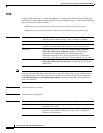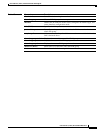
Cisco IOS Voice, Video, and Fax Commands: R Through Sh
sequence-numbers
VR-592
Cisco IOS Voice, Video, Fax Command Reference
sequence-numbers
To enable the generation of sequence numbers in each frame generated by the digital signal processor
(DSP) for Voice over Frame Relay applications, use the sequence-numbers command in dial-peer
configuration mode. To disable the generation of sequence numbers, use the no form of this command.
sequence-numbers
no sequence-numbers
Syntax Description This command has no arguments or keywords.
Defaults Disabled
Command Modes Dial-peer configuration
Command History
Usage Guidelines Sequence numbers on voice packets allow the digital signal processor (DSP) at the playout side to detect
lost packets, duplicate packets, or out-of-sequence packets. This helps the DSP to mask out occasional
drop-outs in voice transmission at the cost of one extra byte per packet. The benefit of using sequence
numbers versus the cost in bandwidth of adding an extra byte to each voice packet on the Frame Relay
network must be weighed to determine whether to disable this function for your application.
Another factor to consider is that this command does not affect codecs that require a sequence number,
such as G.726. If you are using a codec that requires a sequence number, the DSP will generate one
regardless of the configuration of this command.
Examples The following example shows how to disable the generation of sequence numbers for VoFR frames on a
Cisco 2600 series or 3600 series router or on a Cisco MC3810 multiservice concentrator for VoFR dial
peer 200, starting from global configuration mode:
dial-peer voice 200 vofr
no sequence-numbers
Release Modification
12.0(3)XG This command was introduced on the Cisco 2600 and 3600 series
routers and the Cisco MC3810 multiservice concentrator.
12.0(4)T This command was integrated into the Cisco IOS Release 12.0(4)T.


















